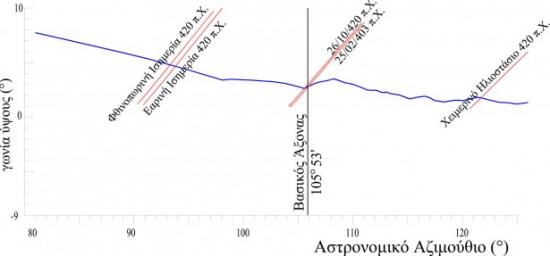Part.2
The Dating
Dating of a monument is defined as the determination of the foundation date of the monument, i.e. the day, the month, and the year by using only geometrical data. According to the presented methodology for this determination the following elements are combined:
- The line which presents the astronomical azimuth of the basic longitudinal axis
- The line which presents the shape of the perceptible horizon and
- The line which presents the path of the sun at a concrete date.
The three aforementioned lines are presented in a common diagram, which has as axis the astronomical azimuth and the altitude (fig. 5).

Fig. 5. Diagram of the east horizon of the Heraion of Argos.
The line of the perceptible horizon is defined as the projection of the mountains or buildings, which are situated in front of the monument on the direction of the main longitudinal axis of the Heraion, on the celestial sphere. Substantially these mountains or buildings block the visibility of an observer standing at this position towards the celestial sphere and the celestial bodies (sun, stars), to the east (Pantazis G., 2002). The east side of the monument is the most significant because this is whre the main entrance of the temple is situated, supervising the site. According to historical sources the famous worship statue of the goddess is situated at the façade of this side.
The shape of this line is computed from pairs of horizontal and zenith angles’ measurements by using a total station. The pairs of the measured angles are transformed to astronomical azimuths and altitudes. In this case the measurements were carried out from point S1.
Figure 6 presents the camera documentation of the perceptible horizon.

Fig. 6. Photographic documentation of the perceptible horizon.
The dating of the monument is being done as follows:
The date (day-month-year) of which the sun’s path coincides or has the minimum distance from the point where the line of the perceptible horizon and the line of the main longitudinal axis’ astronomical azimuth coincide, defines the foundation date of the temple (Pantazis G., 2002).
For this reason several sun’s paths (azimuth, altitude) are calculated for different years, months and days. The digital planetarium Skymap pro8 is used for this purpose. As input data are used the coordinates φ, λ of the monument.
Based on the appropriate investigation, the path of the sun which satisfies the aforementioned concept is February 25th 403 BC. The dating uncertainty is calculated as the ratio of the orientation’s uncertainty to the annual change of the sun’s position. In the case of Heraion the orientation uncertainty is equal to ±3.1′ as the daily change of the sun’s position on the February 25th is equal to ±8″, thus the dating uncertainty was found to be ± 23 years.
Discussion
This paper presents a special geodetic and astrogeodetic methodology of measurement and a procedure for the determination of the astronomical orientation and the dating of Heraion in Argos.
The astronomical orientation of the main axis of the 5th century’s temple calculated equal to 105° 53′. Also the foundation date is February 25th 403BC with uncertainty of ±23 years.
By using the presented methodology the astronomical orientation and the dating of any monument is feasible. The application of the methodology requires the use of the following instrumentation:
- a total station for the geometric documentation of the monument, the determination of the astronomical azimuth and the allocation of the line of the perceptible horizon,
- a GNSS receiver for the determination of the coordinates φ, λ of the monument’s position.
The uncertainty of the determination depends mainly on the size of the monument and the provided uncertainty by the used instrumentation, and it can reach ±10 arcsec.
The methodology is independent from other historical or archaeological data, which are usually used for the monument’s dating. In this way the archaeological dating researches could be supported where other methods either are not effective or have large uncertainty due to data lack.